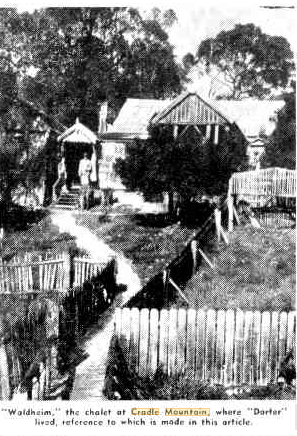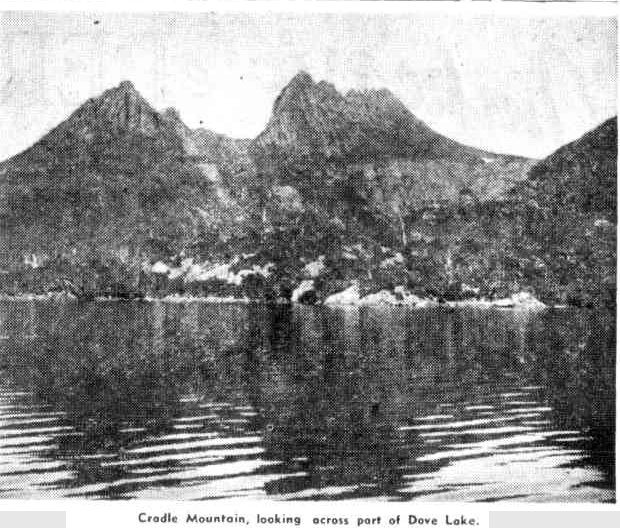In 1949 my grandma, Shirley, climbed Cradle Mountain and her father, Charlie, wrote an article for his local paper in South Australia. I can’t any evidence that Charlie was ever inspired to write for the paper again – his experiences in the Tasmanian Wilderness must have been uniquely inspiring. And they continue to influence his descendants in the state.
We have all been bushwalkers and holidayed in the Tasmanian Wilderness World Heritage Area. Shirley’s daughter had her honeymoon camping near Waldheim, and I’ve even lived in the Cradle Valley, plus I’ve been for a ride in Ranger Connell’s old car – the one that the Gentle’s took to Cradle in 1949!
Beyond our immediate family, the Interpretation Centre at Cradle has photos of a “South Australian family” holidaying there – did they read about the place in Charlie’s article and decide to see it for themselves?
Looking through photos of three generations in the Cradle Valley, it really hits home how these areas we’ve chosen to protect from modernity have stayed so, so much the same and that it’s just our faces that change.
A Tasmanian Adventure by C. Gentle
Chronicle, 8 December 1949, p31
Climbing Cradle Mountain
We had been holidaying in Burnie. Tasmania, a week or so when it was suggested that we make the trip to Cradle Mountain before leaving for Adelaide, so this we planned to do. From the time we boarded the Launceston train at Burnie the trip was full of surprises.
‘Waldheim,’ the chalet at Cradle Mountain, where ‘Dorfer’ lived, reference to which is made in this article.
BETWEEN Burnie and Devonport the railway line follows the rugged coastline. At Railton Junction we left the train and boarded the railcar, especially built for mountain climbing. This took us to Sheffield, at the base of Mount Roland.
There we were met by the proprietor of the Cradle Mountain Chalet in his car. It is necessary to have a high-powered car in order to cover the distance, as the chalet is 3,000 ft. above sea level, Cradle Mountain itself being 5,000 feet.
One hardly notices the bad spots in the road in. the absorption of the scenic beauty of the mountains. The distance covered by car to Cradle Mountain Scenic Reserve is 40 miles.
Here is a wonderland of lakes and mountains unspoilt by civilisation. It is nature as few of us know it.
Just before reaching the chalet the driver pulled up and showed us the peak of Little Horn, part of Cradle towering over Mount Marion.
After tea we all sat around a very large fire in a huge fire place and an old identity told us a most interesting story of the man who built the chalet, which he named “Waldheim.”
It was a story that will remain in our memories indefinitely. I jotted down some of the most important details and here they are: —
Gustav Weindorfer was born in Austria in 1873, and educated at the Vienna University for the Diplomatic service. At the age of 26 he came to Australia as Chancellor in the Austro-Hungarian Consulate, Melbourne, but, tiring of the military nature of politics in Germany and Austria at that time, resigned his post and bought a farm at Sheffield, Tasmania.
He had a passion for the wild natural surroundings of the Tasmanian mountains, which reminded him so much of his beloved Austrian Tyrol.
Soon afterwards he obtained permission to build the chalet, which is made of Tasmanian King William pine, a very valuable timber today.
In the meantime “Dorfer,” as he was known to his friends, had married, and he and his wife spent most of their time between the farm and the chalet.
In the summer months they entertained their visitors at
A patch of snow on the plateau of Cradle Mountain.
“Waldheim” and returned to the farm for the winter months, owing to the inaccessibility of the snow-bound chalet.
* * *
“DORFER’S” wife died in 1916, and he sold the farm at Sheffield and retired to the Chalet.
He still had many visitors in the summer, but in the long winter months had to rely on books and the wild animals for company. “Dorfer” would build a huge fire in the large fire place and then open the door, and with perfect quiet reigning, the wild animals would come in from the snow-covered ground outside and share with him the stillness and the warmth.
In 1932 he was found dead alongside his motor bike, and so was alone in death as so often he had been in life. A monument of stones marks the grave just at the entrance to the gates of the Chalet.
The story left a lasting impression on most of us.
Cradle Mountain, looking across part of Dove Lake.
The following morning, dressed suitably for hiking and mountaineering, we set off, a party of about 15, with our lunch in a knapsack, to climb Cradle Mountain. The base of the mountain is three miles from the Chalet.
It was most interesting to follow the track from “Waldheim” along the many lakes, around Mount Marion, which in itself took some climbing, to the Plateau of Cradle.
I do not think that any of the party will ever forget the first sight of Cradle Mountain rising 2,000 ft. about Dove Lake (not called Dove from its shape, but from the first man who discovered it). Its high, serrated peaks of bare granite rocks were blotted out by a wall of steely clouds, but the peak itself just visible through a rift of clouds.
I wondered where the name had originated, and, on asking our guide, was told that the peak was supposed to resemble a miner’s cradle.
I must admit that only two of the party made the summit, my daughter, 21, the youngest of the party, and our guide, an elderly experienced mountaineer. Considering the fact that the first to climb Cradle were two Austrians with ropes it is not surprising that most of the party only managed to get half-way.




[…] the Hobart Walking Club, brought skiing to Mt Field and assisted Weindorfer in the protection Cradle Mountain. I wonder how involved Rosella and Leslie and their children were in this outdoor life? […]
LikeLike